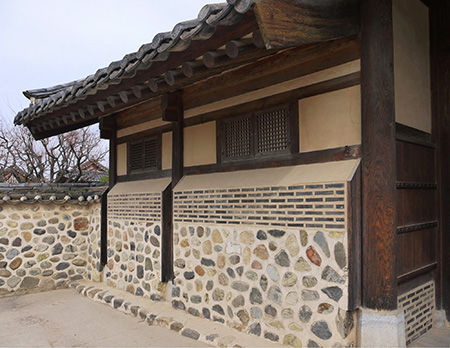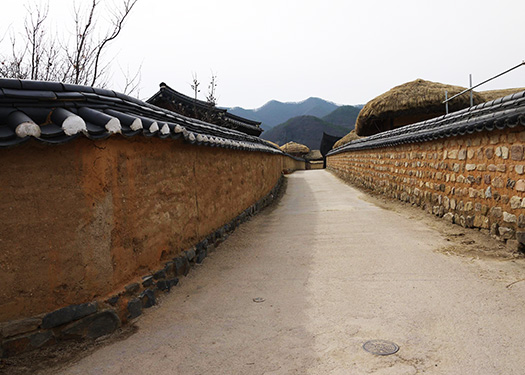

韓国・河回村の環境と住宅群を見ていますが、
目にやわらかく印象が染み込んでくる感覚にとらわれています。
マウルという語感とともにはじめて行ったのに深く懐かしい。
なぜだろうか、と考えると人々の東アジア的表情に親近感を持つのと、
それと相俟って、素材群がどれもアースカラーであることに気付かされる。
それも日本人にもきわめて親近感があふれるような素地の表情。
そのベースには土塗りがあって、この地域で獲れた粘土が使われているに違いない、
地面との色合いの調和ぶりを見ていると深く納得させられる。
いまちょうど地域型住宅の草分けといえる「北方型住宅」論議しているけれど、
そこでは「地域の材料を使う」というコンセプトがいつも語られる。
たしかに地域の樹種は特有の風雪感をもたらしてくれる素材ではあるけれど、
一般人に素朴に訴求してくるものとして「地域の土」というのは、
ものすごくパワフルな素材であると深く認識させられる。
なんと言っても地面がアスファルトではなくこの地域の自然のままの地面。
クルマの進入が制限されていることで文字通り基底での統一感がある。
そしてその色合いが土壁でも主流として使われ街路の壁や住戸の壁の
基本部分を専有している。その土がモルタル的に構造の補助にも役立っている。
木や石はそれぞれ構造や補強材として活用され、
それぞれがまことに正直な美感を提供してくれている。
結局どんな化粧よりも素顔の美しさに人間は究極的に魅了されるのでしょう。
とくに石材は微妙なカラーバリエーションを持っていて魅力的。
木構造はそういった土や石と呼応して幾何形体を表現して
人間知性による統一感をもたらせてくれているかのようです。
瓦もまた、その土地に縁のある土が形を変えたものといえる。
それらのハーモニーが一戸一戸で美しく完結するとともに、
街区全体としての統一感を形成してくれている。
「地域らしさ」というコンセプトを考えるとき、
クルマ社会との整合性を保ちながら地面のデザインまでも含めてその魅力を
考えて行く必要性があるのではないだろうかと思い至った。
コロンブスの卵の再発見のような気付き。
やはりアスファルトはあまりにも普遍性素材であって「地域らしさ」とは縁遠い。
クルマだけの効率性でほかの人類開発の魅力要素を捨て去っていいのだろうか?

わたし的には経産省の進めるZEH論議で指標化している
なんでも太陽光発電でキャンセルという画一化論には疑問がある。
それによって例えば瓦のような優れた人類デザインが失われるようになったとき、
未来の人々からなんと愚かなと指弾される怖れを抱かされる。
このハフェマウルの普遍的な美感から学ぶべきではないだろうか。
English version⬇
[Regional design of soil, wood, stone, and roof tiles: Reminiscences of Andong Hahoe Village, South Korea-10]
I’m looking at the environment and housing groups in Andong Hahoe Village, South Korea.
I am obsessed with the feeling that the impression is soft to the eyes.
I miss it deeply even though I went there for the first time with the word Maul.
When I think about why, I have a feeling of familiarity with people’s East Asian facial expressions.
Combined with that, it is noticed that all the materials are earth tones.
It also has a base expression that is extremely familiar to Japanese people.
Its base has a clay coating and must be made from clay from this area,
It is deeply convincing to see the harmony of the colors with the ground.
We are currently discussing “northern housing,” which can be said to be the pioneer of regional housing.
The concept of “using local materials” is always talked about there.
It is true that the local tree species are materials that bring a unique feeling of wind and snow,
“Regional soil” is a simple appeal to the general public.
It makes me deeply recognize that it is an extremely powerful material.
After all, the ground is not asphalt but the pristine ground of this area.
There is literally a sense of unity at the base because the entry of cars is restricted.
And that color is also used as the mainstream even on earthen walls, and on the walls of streets and dwelling units
It occupies the basic part. The soil is also useful as a mortar to assist the structure.
Wood and stone are used as structures and reinforcements, respectively.
Each one provides a truly honest aesthetic.
After all, human beings will be ultimately fascinated by the beauty of their real faces more than any makeup.
Stones are especially attractive because they have subtle color variations.
The wooden structure expresses a geometrical shape in response to such soil and stones.
It seems that it brings a sense of unity due to human intelligence.
Roof tiles can also be said to have been transformed by the soil associated with the land.
While those harmonies are beautifully completed one by one,
It forms a sense of unity as a whole block.
When thinking about the concept of “locality”
While maintaining consistency with the automobile society, its appeal including the design of the ground
I realized that it might be necessary to think about it.
Isn’t it a rediscovery like the egg of Columbus?
After all, asphalt is a universal material and is far from “locality”.
Is it okay to throw away other attractive elements of human development with the efficiency of the car alone?
Personally, it is indexed by the ZEH discussion promoted by the Ministry of Economy, Trade and Industry.
There is a doubt about the standardization theory that everything is canceled by solar power generation.
When it causes the loss of good human design, such as roof tiles,
I am afraid that future people will tell me how stupid I am.
Shouldn’t we learn from the universal beauty of this Hafemaul?
Posted on 8月 28th, 2021 by 三木 奎吾
Filed under: 住宅マーケティング, 日本社会・文化研究







コメントを投稿
「※誹謗中傷や、悪意のある書き込み、営利目的などのコメントを防ぐために、投稿された全てのコメントは一時的に保留されますのでご了承ください。」
You must be logged in to post a comment.